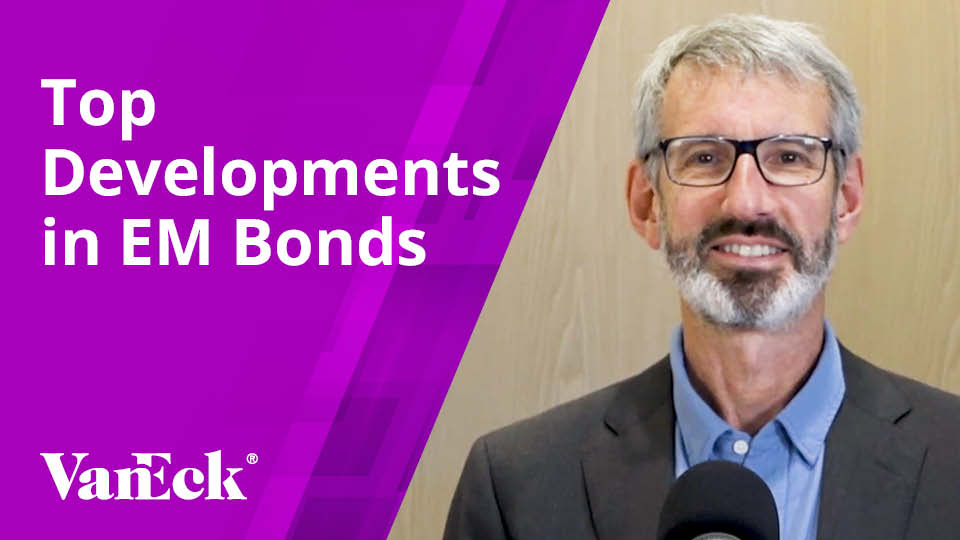Meeting Demand for Income in a Year of Rising Rates
11 February 2022
Summary
The market expects at least four rate hikes beginning in March setting the stage for a tough year for fixed income. Could emerging market bonds be a solution to meeting demand for income?
Federal Reserve Chairman Powell made clear after the recent FOMC meeting that the central bank was ready to raise rates and begin reducing its balance sheet to fight the highest inflation in a generation. The market is now expecting at least four rate hikes beginning in March, and this hawkish tone sets the stage for a tough year for most fixed income asset classes. A popular position right now for asset allocators is to seek the most attractive tradeoff for yield versus duration1, regardless of liquidity. Leveraged loans, private credit and vehicles categorized as “alternative finance” are meeting demand for income that involves low correlation with rates. Most of these alternatives, however, involve either a quality or liquidity give up, or both, that could compound downside during a negative turn in the credit cycle. We believe emerging market bonds remain part of the solution set, with attractive yield versus duration tradeoffs in some EM asset classes, and without as significant a quality or liquidity tradeoff as other high yielding options represent. EM debt may provide a relatively insulated pocket of opportunity to help build more resilient bond income portfolios in this environment.
All else equal, higher yielding asset classes may hold up better as rates rise because a higher level of income earned may help to offset price losses as rates rise. That is why some investors prefer asset classes like high yield corporate bonds over investment grade corporate bonds right now. Emerging markets high yield corporate bonds, as represented by the ICE BofA Diversified High Yield US Emerging Markets Corporate Plus Index, presently offer a significant pick up in yield versus U.S. high yield, as represented by the ICE BofA US High Yield Index, despite having a higher overall average credit quality. Within sovereign bonds, both U.S. dollar and local currency denominated bonds (as represented by the J.P. Morgan EMBI Global Diversified Index and JP. Morgan GBI-EM Global Core Index, respectively) provide relatively attractive yields, but U.S. dollar sovereign bonds are directly tied to U.S. rates and historically carry a high duration, currently at 7.7 as of 1/25/2022. Onshore China, as represented by ChinaBond China High Quality Bond Index, bonds provide lower yields than they did a year ago, but still offer a significant pickup versus U.S. treasuries and the broad U.S. investment grade market, as represented by the ICE BofA US Broad Market Index, without direct exposure to U.S. rates. In fact, China has been cutting rates recently, providing a tailwind to onshore bond returns.
Emerging Markets Yield and Duration Advantage
Source: ICE Data Indices, J.P. Morgan and ChinaBond as of 1/25/2022. EM High Yield Corporate represented by ICE BofA Diversified High Yield US Emerging Markets Corporate Plus Index; LC EM Sovereigns represented by J.P. Morgan GBI-EM Global Core Index; USD EM Sovereigns represented by J.P. Morgan EMBI Global Diversified Index; US High Yield Corporates represented by ICE BofA US High Yield Index; China Onshore Bonds represented by ChinaBond China High Quality Bond Index; US IG Corporates represented by ICE BofA US Corporate Index; US Agg represented by ICE BofA US Broad Market Index.
Notwithstanding China’s more recent policy direction, emerging markets in general have moved much more quickly to increase interest rates compared to the U.S. and other developed market rates in order to stay ahead of inflation. The result has been not only higher nominal yields, but higher real yields. The benefits to EM local currency investors are a more substantial level of income that is not eroded by loss of purchasing power (through a potentially weaker currency) and the potential for rate cuts to stimulate growth, if needed. The supportive case for emerging market currencies begins with valuations, which have been deeply discounted relative to their history for several years. Further, with crude oil recently hitting its highest level since 2014, and many other commodities benefiting from growth and inflationary forces, many EM countries, particularly in Latin America, Africa and parts of Eastern Europe, stand to receive an extended economic boost. Net commodity exporters make up a much more significant portion of most EM local debt indexes than they do of EM equity indexes, which tend to be much more concentrated in the Asian export led economies.
For historical reference, below we show two extended rising rate, reflationary periods that have occurred since 2000. Local currency emerging market bonds performed well in both of these periods compared to rate sensitive U.S. investment grade aggregate bonds. Although EM local bonds underperformed U.S. high yield corporates slightly in the 2015-2019 period, the asset class is predominantly investment grade and therefore provided relatively safer exposure from a credit perspective. Emerging markets high yield corporates outperformed U.S. high yield corporates in this latter period (because index history does not exist prior to 12/31/2004, EM high yield is excluded from the 2004-2007 chart).
EM Debt vs US Fixed Income and Fed Funds 2004 – 2007
6/30/2004 - 6/30/2007
EM Debt vs US Fixed Income and Fed Funds 2015 – 2019
9/30/2015 - 6/30/2019
Source: J.P. Morgan, ICE Data Indices and Board of Governors of the Federal Reserve System as of 1/25/2022. EM HY Corp represented by ICE BofA Diversified High Yield US Emerging Markets Corporate Plus Index; LC EM Sovereigns represented by J.P. Morgan GBI-EM Global Core Index; US HY represented by ICE BofA US High Yield Index; US Agg represented by ICE BofA US Broad Market Index.
1 Duration is a measure of the sensitivity of the price -- the value of principal -- of a fixed-income investment to a change in interest rates. Duration is expressed as a number of years.
Index descriptions:
ChinaBond China High Quality Bond Index tracks fixed-rate, Renminbi ("RMB")-denominated bonds issued in the People's Republic of China by Chinese credit, governmental and quasi-governmental (e.g., policy banks) issuers.
ICE BofA Diversified High Yield US Emerging Markets Corporate Plus Index tracks the performance of US dollar denominated below investment grade emerging markets non-sovereign debt publicly issued in the major domestic and eurobond markets.
ICE BofA US Broad Market Index tracks the performance of US dollar denominated investment grade debt publicly issued in the US domestic market, including US Treasury, quasi-government, corporate, securitized and collateralized securities.
ICE BofA US Corporate Index tracks the performance of US dollar denominated investment grade corporate debt publicly issued in the US domestic market.
ICE BofA US High Yield Index tracks the performance of US dollar denominated below investment grade corporate debt publicly issued in the US domestic market.
J.P. Morgan GBI-EM Global Core Index tracks bonds issued by emerging markets governments and denominated in the local currency of the issuer. The weighting scheme provides additional diversification by more evenly distributing weights among the countries in the index. Countries are capped at 10% and floored between 1% to 3%.
J.P. Morgan GBI-EM Global Diversified Index tracks emerging markets local government bonds that are accessible by most foreign investors. The weighting scheme provides additional diversification by more evenly distributing weights among the countries in the index. Countries are capped at 10%.
J.P. Morgan EMBI Global Diversified Index tracks USD-denominated emerging markets sovereign bonds. The weighting scheme provides additional diversification by more evenly distributing weights among the countries in the index.
Informations importantes
À des fins d’information et de publicité uniquement.
Ces informations proviennent de VanEck (Europe) GmbH qui a été désignée comme distributeur des produits VanEck en Europe par la société de gestion VanEck Asset Management B.V., de droit néerlandais et enregistrée auprès de l’Autorité néerlandaise des marchés financiers (AFM). VanEck (Europe) GmbH, dont le siège social est situé Kreuznacher Str. 30, 60486 Francfort, Allemagne, est un prestataire de services financiers réglementé par l’Autorité fédérale de surveillance financière en Allemagne (BaFin). Les informations sont uniquement destinées à fournir des informations générales et préliminaires aux investisseurs et ne doivent pas être interprétées comme des conseils d’investissement, juridiques ou fiscaux. VanEck (Europe) GmbH et ses sociétés associées et affiliées (ensemble « VanEck ») n’assument aucune responsabilité en ce qui concerne toute décision d’investissement, de cession ou de rétention prise par l’investisseur sur la base de ces informations. Les points de vue et opinions exprimés sont ceux du ou des auteurs, mais pas nécessairement ceux de VanEck. Les avis sont à jour à la date de publication et sont susceptibles d’être modifiés en fonction des conditions du marché. Certains énoncés contenus dans les présentes peuvent constituer des projections, des prévisions et d’autres énoncés prospectifs qui ne reflètent pas les résultats réels. Les informations fournies par des sources tierces sont considérées comme fiables et n’ont pas été vérifiées de manière indépendante pour leur exactitude ou leur exhaustivité et ne peuvent être garanties. Tous les indices mentionnés sont des mesures des secteurs et des performances du marché commun. Il n’est pas possible d’investir directement dans un indice.
Toutes les informations sur le rendement sont historiques et ne garantissent pas les résultats futurs. L’investissement est soumis à des risques, y compris la perte possible du capital. Vous devez lire le Prospectus et le DICI avant d’investir.
Aucune partie de ce matériel ne peut être reproduite sous quelque forme que ce soit, ou mentionnée dans toute autre publication, sans l’autorisation écrite expresse de VanEck.
© VanEck (Europe) GmbH
Inscrivez-vous maintenant à notre newsletter
Related Insights
Related Insights
08 janvier 2025
23 juillet 2024
01 mai 2024
08 janvier 2025
06 août 2024
23 juillet 2024
16 avril 2024
15 novembre 2023





